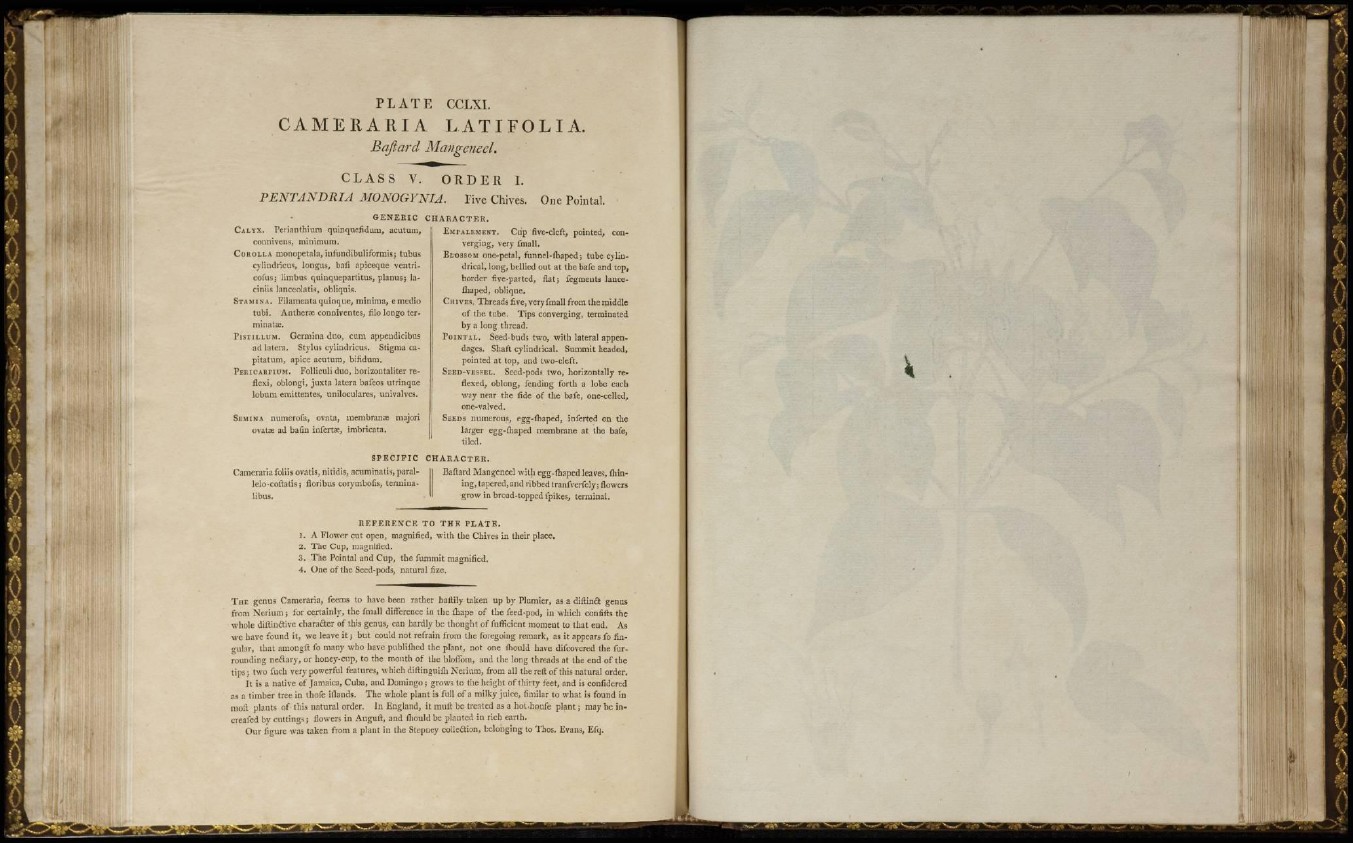
PLATE CCLXI.
CAMER A R I A L A T I F O L I A.
Baßard MangeneeL
CLASS V. ORDER I.
PENTANDR1A MONOGYNIA. Five Chives. One Pointal.
G E N E R I C C
C A L Y X . Perianthium quinquefidum, acutum,
connivens, minimum.
C O R O L L A monopetala, infundibuliformis; tubus
cylindricus, longvis, bafi apiceque ventricofus;
limbus q u i n q u e p a r t i t u s , planus; laciniis
lanceolatis, obliquis.
S T A M I N A . F i l a m e n t a q u i n q u é , minima, e m e d io
t u b i . Antherx conniventes, filo longo terminatie.
PisTiLLUM. Germina duo, cum appendicibus
ad latera. Stylus cylindiicus. Stigma cap
i t a t n m , apice acutum, bifidum.
P E R I C A R D I U M . Folliculi duo, horizon tali ter reflexi,
oblongi, j u x t a latera bafeos u t r i n q ue
l o b um emitientes, uniloculares, univalves.
S E M I N A numerofa, ova t a , membrana; majori
ovaUe ad ba fin inlèrtae, imbrica t a .
E M P A L E M E N T . Cup five-cleft, pointed, converging,
very fmall.
BLOSSOM one-petal, funnel-fliapcd; tube cylindrical,
long, bellied out at t h e bafe and top,
border five-parted, flat; fegments lancefliaped,
oblique.
C H I V E S . Threads rive, very fmall from t h e middle
of the tube. Tips converging, terminated
by a long thread.
P O I N T A L , Seed-buds two, with lateral appendages.
Shaft cylindrical. Summit headed,
pointed at top, and two-cleft.
SEED- V E S S E L . Secd-pods two, horizontally re-
Hexed, oblong, fending forth a lobe each
way near the fide of the bale, one-celled,
one-valved.
SEEDS numerous, egg-fhaped, inferted on the
larger egg-fhaped membrane at the bafe,
t i l e d.
S P E C I F I C CHARACTER.
Camerariafoliis ovatis, nitidis, acuminatis, paral- || Eaflard Mangeneel w i t h egg-fhaped leaves, fliinlelo
coftatis; floribus corymbofis, termina- ing,tapered,and ribbedtranfverfely; flowers
libus. 'I grow in broad-topped fpikes, terminal.
REFERENCE TO THE PLATE.
1 . A Flower cut open, magnified, with t h e Chives in their place.
2. T h e Cup, magnified.
3 . T h e Pointal and Cup, the fummit magnified.
4 . One of the Seed-pods, natural fize.
T H E genus Carncraria, feems to have been rather haftily taken up b y Plumier, as a difiinct genus
from N e r i u m ; for c e r t a i n l y , the fmall difference in t h e fliape of the feed-pod, in which confifts the
whole diftinctive character of this genus, can hardly be thought of lutficient moment to t h a t end. As
we have found it, we leave i t ; but could not refrain from the foregoing remark, as it appears fo finguiar,
that amongit fo many who have p u b l i i h e d the plant, not one fhould have difcovcred the furr
o u n d i n g nectary, or honey-cup, to the mouth of the blotlbm, and the long threads at the end of the
t i p s ; two fuch very powerful features, w h i c h diflinguifli Xerium, from all t h e reft of this natural order.
I t is a native of Jamaica, Cuba, and D o m i n g o ; grows to the height of t h i r t y feet, and is confidered
as a timber tree in thofe iflands. The whole plant is full of a milky j u i c e , iimilar to what is found in
moll plants of this n a t u r a l order. In England, it mull be treated as a h o t . h o u f e p l a n t ; may be increafed
by c u t t i n g s ; flowers in Atigult, and fliouhl be planted in rich earth.
Our figure was taken fiom a plant in the Stepney collection, belonging to Thos. Evans, Efq.